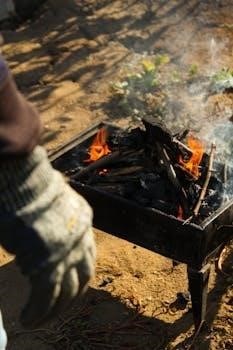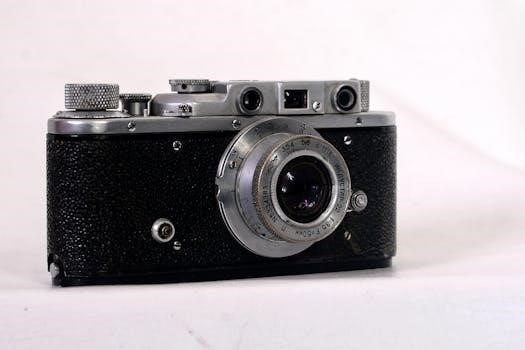BattleMech Manual⁚ A Comprehensive Guide
This manual serves as a comprehensive guide to BattleMechs, the iconic war machines of the 31st century. This guide delves into the history of these mechs. It offers technical specifications, combat roles, and resources for further exploration.
BattleMechs, often shortened to ‘Mechs, are armored combat vehicles of roughly humanoid shape, typically standing 8 to 14 meters tall. These war machines generally mass from 20 to 100 tons. They are best suited for ground combat, though some possess jump jets for added maneuverability. BattleMechs reached their zenith during the Star League era.
The ‘Mech emerged as the king of the battlefield on February 5, 2439, when the Mackie obliterated all opposition during its first combat trial. This marked the beginning of a new age of warfare. BattleMechs are divided into four distinct categories based on weight⁚ light, medium, heavy, and assault.

A MechWarrior must understand the tools of their trade. Dense forests, swamps, and steep slopes will slow a ‘Mech. However, very few terrain features can truly stop one. These technological marvels have revolutionized warfare, and this manual will provide a deep dive into their capabilities.
BattleMech Definition and Overview
A BattleMech is an armored combat vehicle, characteristically humanoid in form, usually standing between 8 and 14 meters in height. Weighing between 20 and 100 tons, these bipedal war machines are designed for ground combat. Although primarily ground-based, many are capable of limited aerial movement via jump jets, enhancing their tactical flexibility on the battlefield.
BattleMechs are categorized into four weight classes⁚ Light, Medium, Heavy, and Assault, each designed for specific combat roles. Light ‘Mechs excel in reconnaissance and harassment, while Medium ‘Mechs provide versatile support. Heavy ‘Mechs offer a balance of firepower and armor, and Assault ‘Mechs serve as the heavy hitters, designed to break enemy lines.
These machines are composed of various critical components, including armor, internal structure, weapons systems, and engine and heat management systems. Understanding these elements is crucial for effective deployment and maintenance. BattleMechs represent the pinnacle of military technology in the BattleTech universe.
Historical Significance⁚ The Rise of the BattleMech
The history of the BattleMech is intrinsically tied to the evolution of warfare in the BattleTech universe. Their dominance began on February 5, 2439, when the Mackie obliterated all opposition, ushering in a new era. The BattleMech quickly became the king of the battlefield, eclipsing traditional tanks and aircraft due to its superior mobility, firepower, and survivability.
The golden age of the Star League saw BattleMech technology reach its zenith, with advanced designs and widespread deployment across the Inner Sphere. This era was marked by relative peace and technological advancement, with BattleMechs serving as symbols of power and stability. However, the collapse of the Star League and the ensuing Succession Wars plunged the Inner Sphere into centuries of brutal conflict.
During this time, BattleMech production and maintenance became increasingly difficult, leading to the loss of technological knowledge and the rise of salvage and repair as essential skills. Despite the decline, BattleMechs remained the dominant force on the battlefield. The BattleMech is an enduring symbol of military might.

Technical Specifications and Design
This section explores the crucial technical aspects of BattleMechs, including weight classes (Light, Medium, Heavy, Assault), key components like armor and weapons, and the vital engine and heat management systems that define their combat capabilities.
BattleMech Weight Classes⁚ Light, Medium, Heavy, Assault
BattleMechs are categorized into four distinct weight classes, each dictating their role and capabilities on the battlefield. Light ‘Mechs, typically weighing 20-35 tons, prioritize speed and maneuverability, excelling in reconnaissance and skirmishing roles. Their lighter armor makes them vulnerable to heavier firepower, demanding skilled piloting and tactical awareness. Medium ‘Mechs, ranging from 40-55 tons, strike a balance between firepower, armor, and speed, serving as versatile generalists capable of fulfilling various combat roles.
Heavy ‘Mechs, weighing 60-75 tons, sacrifice some speed for increased firepower and armor protection, making them formidable frontline combatants. They can withstand significant damage while delivering substantial offensive capabilities. Assault ‘Mechs, the behemoths of the battlefield, weigh 80-100 tons and boast the heaviest armor and most devastating weaponry. Their slow speed limits their maneuverability, but their sheer resilience and firepower make them ideal for breaking enemy lines and engaging in protracted engagements.
The choice of weight class depends on the mission objectives and strategic deployment. Understanding the strengths and weaknesses of each class is crucial for effective tactical decision-making.
Key Components⁚ Armor, Structure, Weapons Systems
A BattleMech’s combat effectiveness hinges on three key components⁚ armor, internal structure, and weapon systems. Armor protects the internal structure from enemy fire, absorbing and dissipating energy. It’s measured in points and varies in thickness and composition depending on location. Internal structure represents the ‘Mech’s skeletal framework, providing support and housing critical systems. Damage to the internal structure can impair mobility, weapon functionality, or even lead to catastrophic destruction.
Weapon systems are the ‘Mech’s means of inflicting damage, ranging from energy weapons like lasers and PPCs to ballistic weapons like autocannons and machine guns, and missile systems like LRMs and SRMs. Energy weapons generate heat, requiring careful management to avoid system shutdowns. Ballistic weapons rely on ammunition, limiting their sustained firepower. Missile systems offer versatility but are susceptible to electronic countermeasures.
The interplay between these three components determines a ‘Mech’s survivability and offensive capabilities; Balancing armor, structure, and weaponry is crucial for optimal battlefield performance.
Engine and Heat Management Systems
The engine and heat management systems are vital for a BattleMech’s operation. The engine provides the power necessary for movement and weapon operation. ‘Mechs utilize fusion engines, which are powerful but generate substantial heat as a byproduct. This heat must be efficiently managed to prevent system failures and potential explosions.
Heat sinks are the primary component of a ‘Mech’s heat management system, dissipating excess heat into the atmosphere. Insufficient heat sinks can lead to overheating. Overheating causes temporary shutdowns, reduced weapon accuracy, and even internal damage. ‘MechWarriors must carefully balance weapon usage and movement to manage heat levels effectively.
Advanced heat management technologies, such as double heat sinks and heat exchangers, can improve a ‘Mech’s ability to dissipate heat. These advanced systems allow for sustained firepower and greater mobility without the risk of overheating. Efficient heat management is a crucial skill for any MechWarrior.

Battlefield Tactics and Combat Roles
BattleMechs are deployed in various combat roles, each exploiting specific strengths. Battlefield tactics depend on terrain, enemy composition, and mission objectives. Effective ‘MechWarriors understand maneuverability, strategic positioning, and team coordination for battlefield success.
Terrain Considerations⁚ Movement and Maneuverability
Terrain significantly impacts BattleMech movement and maneuverability. Dense forests and swamps slow ‘Mechs, while steep slopes can impede progress. Understanding these limitations is crucial for strategic deployment and tactical decision-making. Skilled MechWarriors use terrain to their advantage, maximizing cover and minimizing exposure to enemy fire. Some ‘Mechs possess jump jets, allowing them to overcome obstacles and gain advantageous positions.
Urban environments present unique challenges, requiring careful navigation through narrow streets and around buildings. Open terrain favors faster ‘Mechs, while mountainous regions offer opportunities for ambushes and flanking maneuvers. A ‘Mech’s weight class and engine power influence its ability to traverse different terrains effectively.
Environmental conditions, such as rain or snow, can further complicate movement, reducing traction and visibility. Mastering terrain awareness is essential for survival and success on the battlefield. Terrain features can also offer defensive advantages, such as elevated positions providing increased firing range. Careful consideration of terrain ensures efficient movement and enhances a ‘Mech’s overall combat effectiveness.
Strategic Deployment and Team Composition
Strategic deployment and team composition are paramount for BattleMech combat success. A balanced team should include ‘Mechs from various weight classes, each fulfilling specific roles. Light ‘Mechs excel at scouting and flanking, while medium ‘Mechs provide versatile support. Heavy ‘Mechs offer firepower and durability, and assault ‘Mechs serve as the main battle force.
Deployment should consider terrain, objectives, and enemy composition. Spreading ‘Mechs across the battlefield can prevent encirclement, while concentrating firepower can overwhelm key targets. Communication and coordination are essential for executing complex maneuvers and reacting to changing battlefield conditions. A well-coordinated team can exploit enemy weaknesses and capitalize on opportunities.
Consideration of pilot skills and ‘Mech customization is crucial for optimizing team performance. Assigning skilled pilots to specialized ‘Mechs maximizes their effectiveness. Customizing ‘Mechs to suit specific roles enhances their capabilities. Effective strategic deployment and team composition lead to tactical advantages.

Resources and Further Information
To deepen your knowledge of BattleMechs, explore Technical Readouts for in-universe descriptions. Use record sheets and design programs to customize your mechs. Consider collecting miniatures to engage with the tactile side of BattleTech.
Technical Readouts⁚ In-Universe Descriptions and Stats
Technical Readouts (TROs) are indispensable resources for BattleTech enthusiasts, providing in-depth, in-universe descriptions. These documents showcase a wide array of BattleMechs, combat vehicles, and support units, offering a unique perspective on the weaponry and war machines of the 31st century. TROs blend narrative flavor with technical specifications, allowing players to understand the history, capabilities, and quirks of each machine.
Within these readouts, you’ll find detailed statistics that are crucial for gameplay, allowing players to make informed decisions when selecting units for combat. They offer insight into various BattleMechs, combat vehicles, support vehicles, VTOLs, and fighters. These statistics, combined with the in-universe narratives, provide a comprehensive understanding of each unit. Technical Readouts do not include record sheets, but can be used with mech design programs.
Technical Readouts paint a vivid picture of the BattleTech universe, making them essential reading for any MechWarrior seeking to master the art of mechanized warfare. Often considered fun and insightful, TROs give game stats for a given time period.
Record Sheets and Mech Design Programs
Record sheets are essential tools for BattleTech players, providing a detailed breakdown of a BattleMech’s capabilities and status during gameplay. These sheets track critical information such as armor levels, weapon loadouts, heat management, and internal damage. They serve as a real-time log of a ‘Mech’s condition, allowing players to make informed tactical decisions in the heat of battle. Record sheets are not found in technical readouts and can be printed off or created using a mech design program.
Mech design programs, such as MegaMekLab, offer a digital alternative to traditional record sheets. These programs allow players to customize their BattleMechs, experiment with different weapon configurations, and track their performance in simulated combat scenarios. Moreover, MegaMekLab comes with every unit ever, making it an invaluable resource for both novice and experienced players.
These programs often include features such as automated record sheet generation, advanced heat management calculations, and real-time damage tracking. By using record sheets and mech design programs, players can enhance their understanding of BattleMech mechanics.
Miniatures and Collectibles
BattleTech miniatures and collectibles offer enthusiasts a tangible connection to the vast universe of armored combat. These meticulously crafted models bring the iconic BattleMechs to life, allowing players to assemble, paint, and showcase their favorite war machines. From the nimble light ‘Mechs to the hulking assault behemoths, a wide variety of miniatures are available; These miniatures cater to collectors and wargamers alike.
Collecting BattleTech miniatures is a popular hobby, with many enthusiasts seeking out rare or limited-edition models. These collectibles often feature intricate details and historical significance, representing specific ‘Mechs from pivotal battles or iconic units. Whether displayed on shelves or used in tabletop battles, these miniatures serve as a testament to the enduring appeal of the BattleTech universe.
Furthermore, the use of miniatures enhances the tactical depth of the tabletop game, allowing players to visualize battlefield scenarios and maneuver their ‘Mechs with precision. With a vast array of options available, BattleTech miniatures and collectibles provide a gateway for fans to immerse themselves.